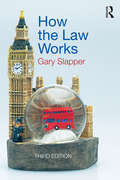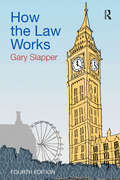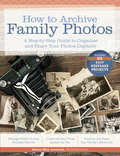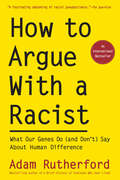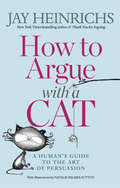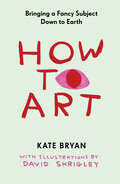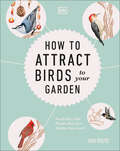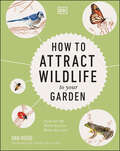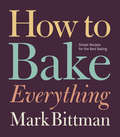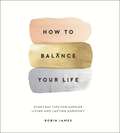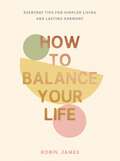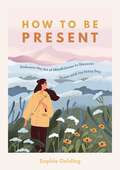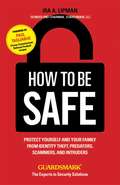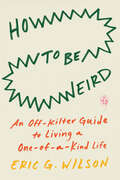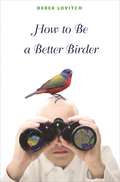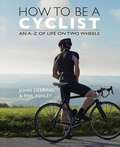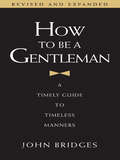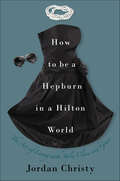- Table View
- List View
How the Hot Dog Found Its Bun: Accidental Discoveries and Unexpected Inspirations That Shape What We Eat and Drink
by Josh ChetwyndSometimes it&’s neither art nor science that serves as the origins of the everyday kitchen and food items that we take for granted today. Sometimes, as Josh Chetwynd shows us in How the Hot Dog Found Its Bun, some of our greatest culinary achievements were simply by-products of &“damned good luck.&” In How the Hot Dog Found Its Bun, Josh explores the origins of kitchen inventions, products, and foodstuff in seventy-five short essays that dispel popular myths and draw lines between food facts and food fiction. Josh&’s charming text combined with simple line illustrations makes this an excellent gift and go-to source book for all food and trivia buffs.
How the Law Works
by Gary SlapperHow the Law Works is a refreshingly clear and reliable guide to the legal system in the UK. Offering interesting and comprehensive coverage, it makes sense of all the curious features of the law in day to day life and in current affairs. Explaining the law and legal jargon in plain English, it provides an accessible entry point to the different types of law and legal techniques, as well as the impact of European law and human rights law. In addition to explaining the role of judges, lawyers, juries and parliament, it clarifies the mechanisms behind criminal and civil law. How the Law Works is essential reading for anyone approaching law for the first time, or for anyone who is interested in an engaging introduction to the subject’s bigger picture.
How the Law Works
by Gary Slapper‘How the Law Works is a gem of a book, for law students and for everyone else. It is a must read for anyone interested in how society is shaped and controlled via law.’ Dr Steven Vaughan, solicitor, Senior Lecturer, Birmingham Law School ‘How the Law Works is a comprehensive, witty and easy-to-read guide to the law. I thoroughly recommend it to non-lawyers who want to improve their knowledge of the legal system and to potential students as an introduction to the law of England and Wales.’ HH Judge Lynn Tayton QC Reviews of the first edition: ‘A friendly, readable and surprisingly entertaining overview of what can be a daunting and arcane subject to the outsider.’ The Law Teacher ‘An easy-to-read, fascinating book . . . brimful with curios, anecdote and explanation.’ The Times How the Law Works is a refreshingly clear and reliable guide to today’s legal system. Offering interesting and comprehensive coverage, it makes sense of all the curious features of the law in day to day life and in current affairs. Explaining the law and legal jargon in plain English, it provides an accessible entry point to the different types of law and legal techniques, as well as today’s compensation culture and human rights law. In addition to explaining the role of judges, lawyers, juries and parliament, it clarifies the mechanisms behind criminal and civil law. How the Law Works is essential reading for anyone approaching law for the first time, or for anyone who is interested in an engaging introduction to the subject’s bigger picture.
How the Queen Cleans Everything: Handy Advice for a Clean House, Cleaner Laundry, a
by Linda CobbA how-to manual for housekeeping amateurs and pros alike, How the Queen Cleans Everything is a collection of fast and ingenious tips from #1 New York Times bestselling author -- and housekeeping's royal lady -- Linda Cobb, the Queen of Clean®. It's all here. All of the Queen's miraculous tips and surprising shortcuts on how to solve hundreds of cleaning challenges -- inside and out. Let the Queen show you how to turn your home into a sparkling palace in no time at all. Learn how to put an end to washday drudgery with her collection of nifty and natural solutions for stress-free washing and ironing -- and enjoy a year's worth of tips, tricks, and picks for a cleaner house and a more organized life. But most of all, discover how the Queen's no-nonsense "tips and hints" method of housekeeping means less time cleaning your home, and more time enjoying it! Let the Queen show you: the best way to clean your kitchen and bathroom the multitude of natural stain removers that are hiding in your cupboard how to garden the natural way what to do for spots, stains, scorch marks, and odors why you shouldn't clean your windows with newspaper how to clean your carpet and bare floors the right way to allergy-proof your home what those care labels really mean how to treat troublesome stains and delicate fabrics...and much more! At last...all the Queen of Clean's® famous advice for a clean house, cleaner laundry, and a year of timely tips -- right at your fingertips! Don't be home without it!
How to Achieve a Heaven on Earth
by John E. II WadeWhether it's finding spiritual harmony, reducing carbon emissions, quelling hostilities among races, cutting taxes, or feeding the hungry, every single person has the capacity to change the world for the better. Longtime New Orleans writer, editor, and philanthropist John E. Wade II has asked some of our most prestigious thinkers, writers, artists, experts, and leaders to consider how to improve the world. The result--this ambitious volume--is as much a social mission as it is an inspirational anthology. Herein lie thoughtful and hopeful reflections on a rich variety of issues, ranging from racism, poverty, religious persecution, genocide, and environmental deterioration to individual consciousness, mental well-being, and community development.One hundred one contributions from such notable personalities as Al Gore, Tony Blair, Nicholas Kristof, Thomas L. Friedman, and George W. Bush explore variations on the themes of peace, security, freedom, democracy, prosperity, spiritual and racial harmony, ecology, health, and moral purpose and meaning. Focusing on the large problems of the world without losing sight of the little challenges people face every day, this collection of essays encourages readers to find meaning in their own lives and share it with others for the betterment of the world. Religious and secular, liberal and conservative, old and young, the luminaries who have contributed to this work offer their voices and thoughts to inspire movement toward creating a more harmonious world community.
How to Archive Family Keepsakes: Learn How to Preserve Family Photos, Memorabilia and Genealogy Records
by Denise May LevenickOrganize your family photos, heirlooms, and genealogy records In every family someone ends up with Mom's and Dad's "stuff"-a lifetime's worth of old family photos, papers, and memorabilia packed into boxes, trunks, and suitcases. This inheritance can be as much a burden as it is a blessing. How do you organize your loved one's estate in a way that honors your loved one, keeps the peace in your family and doesn't take over your home or life? How to Archive Family Keepsakes gives you step-by-step advice for how to organize, distribute and preserve family heirlooms. You'll learn how to: Organize the boxes of your parents' stuff that you inherited Decide which family heirlooms to keep Donate items to museums, societies, and charities Protect and pass on keepsakes Create a catalog of family heirlooms Organize genealogy files and paperwork Digitize family history records Organize computer files to improve your research Whether you have boxes filled with treasures or are helping a parent or relative downsize to a smaller home, this book will help you organize your family archive and preserve your family history for future generations.
How to Archive Family Photos: A Step-by-Step Guide to Organize and Share Your Photos Digitally
by Denise May LevenickOrganize and enjoy your family's memories! You've captured countless cherished family photos of babies' first steps, graduations, weddings, holidays, vacations, and priceless everyday moments on your smartphone or digital camera. Perhaps you've inherited a collection of heirloom family photographs, too. But now what? How to Archive Family Photos is a practical how-to guide for organizing your growing digital photo collection, digitizing and preserving heirloom family photos, and sharing your treasured photos. In this book, you'll find: Simple strategies to get your photos out of a smartphone or camera and into a safe storage space Easy methods to organize and back up your digital photos, including file-naming and tagging hints Achievable steps to digitize and preserve heirloom family photos Step-by-step workflows illustrating common photo organizing and digitizing scenarios Checklists for setting up your own photo organization system 25 photo projects to preserve, share, and enjoy your family photos Whether you have boxes full of tintypes and black-and-white photographs, an ever-growing collection of digital photos, or a combination of the two, this book will help you rescue your images from the depths of hard drives and memory cards (or from the backs of closets) so that you can organize and preserve your family photo collection for future generations.
How to Argue With a Racist (and Don't) Say About Human Difference: What Our Genes Do (and Don't) Say About Human Difference
by Adam RutherfordThis authoritative debunking of racist claims that masquerade as “genetics” is a timely weapon against the misuse of science to justify bigotry—now in paperback Race is not a biological reality. Racism thrives on our not knowing this. In fact, racist pseudoscience has become so commonplace that it can be hard to spot. But its toxic effects on society are plain to see: rising nationalism, simmering hatred, lost lives, and divisive discourse. Since cutting-edge genetics are difficult to grasp—and all too easy to distort—even well-intentioned people repeat stereotypes based on “science.” But the real science tells a different story: The more researchers learn about who we are and where we come from, the clearer it becomes that our racial divides have nothing to do with observable genetic differences. The bestselling author of A Brief History of Everyone Who Ever Lived explains in this explosive, essential guide to the DNA we all share.
How to Argue with a Cat: A Human's Guide to the Art of Persuasion
by Jay Heinrichs Natalie Palmer-SuttonLearn how to persuade cats—the world’s most skeptical and cautious negotiators—with this primer on rhetoric and argument from the New York Times bestselling author of Thank You for Arguing!Cats are skilled manipulators who can talk you into just about anything without a single word (or maybe a meow or two). They can get you to drop whatever you’re doing and play with them. They can make you serve their dinner way ahead of schedule. They can get you to sit down in an instant to provide a lap. On the other hand, try getting a cat to do what you want....While it’s hard, persuading a cat is possible. And after that, persuading humans becomes a breeze, and that is what you will learn in this book. How to Argue with a Cat will teach you how to:· Hold an intelligent conversation—one of the few things easier to do with a cat than a human.· Argue logically, even if your opponent is furry and irrational.· Hack up a fallacy (the hairball of logic).· Make your body do the talking (cats are very good at this).· Master decorum: the art of fitting in with cats, venture capitalists, or humans.· Learn the wisdom of predator timing to pounce at the right moment.· Get someone to do something or stop doing it.· Earn any creature’s respect and loyalty.
How to Art: Bringing a Fancy Subject Down to Earth
by Kate BryanA funny, inviting, full-color book about art for people who don&’t know about &“art&”—featuring new artworks by David Shrigley. What is art, where do I find it, and once I&’m in front of it, what am I supposed to think about it? Kate Bryan is a self-confessed art addict who has worked with art for over twenty years. But before she studied art history at university, she&’d visited a gallery just twice in her life and had no idea she was entering an elitist world. Now, she&’s on a mission to help everybody come to art. Like playing or listening to music, or cooking and eating great food, reading or watching films, making art or looking at other people&’s deserves to be an enriching part of all our lives. How to Art provides a nifty way to ingest art on your own terms. From where it is to what it is, to tips on how to actually enjoy famous artworks like the Mona Lisa, to how to own art and make art at home, to vital advice for making a career as an artist and even how to make your dog more cultural, How to Art gives art to everyone—and makes it fun. Laced throughout with original artworks by the very down-to-earth artist David Shrigley.
How to Attract Birds to Your Garden: Foods they like, plants they love, shelter they need
by Dan RouseHelp your local wild birds by providing them with a safe garden environmentMake a difference to your local birdlife. Help reverse the decline in bird numbers by creating a haven in which they will thrive. It's a win-win. Provide the best shelter, feeding, and nesting opportunities for them and then you can reap the rewards as they sing and entertain.No need to be an expert gardener already, or to break the bank - many of the most beneficial features can be installed easily and cheaply, and many you can build yourself or upcycle to be eco-friendly.
How to Attract Wildlife to Your Garden: Foods They Like, Plants They Love, Shelter They Need
by Dan RouseTransform your garden into a haven for all kinds of wildlife.In a world with too much concrete and not enough greenery, every wildlife-friendly garden can make a huge difference. But what if we told you that you can make a difference to your local wildlife from the comfort of your own home? You can help to reverse the decline in bird numbers and much more by creating a haven in which they will thrive! Let author, presenter, and wildlife conservationist Dan Rouse show you how you can make your outdoor space more welcoming for a wide variety of visitors, from planting pollinator-friendly perennials to digging a pond. Learn the best ways to provide shelter, food, and water, discover the best planting choices and how they can help, then sit back and watch as your garden becomes a much-needed refuge for a huge range of species.Dive straight in to discover:- A beautiful mixture of full-color illustrations and photos of different species.- Practical advice on supporting local wildlife, with ideas suitable for all budgets and abilities.- Suggestions for beneficial plant choices for a range of climate and soil types.- Step-by-step projects tailored to both attracting wildlife and to observe the wildlife that visits the garden.- Ideas for small gardens and outdoor spaces, as well as practical considerations such as pets and children sharing a garden with wildlife.- Final chapter on &‘Observing garden wildlife&’ that showcases low- and high-tech methods of watching for wildlife, and how to connect with the wider wildlife community. The book features plenty of projects to help you attract and observe your new garden visitors, as well as galleries of common species you can expect to see. Following in the footsteps of its sister title How to Attract Birds to Your Garden, everything in the book is clear, accessible, and engaging, with plenty of budget-friendly tips and ideas suitable for gardeners and non-gardeners alike. Packed with equal parts expertise and passion, How to Attract Wildlife to Your Garden proves that, by giving nature opportunities to thrive, we all benefit: ourselves, our planet, and the wildlife that may call our garden home.
How to Bake Everything: Simple Recipes for the Best Baking
by Mark BittmanIn the most comprehensive book of its kind, Mark Bittman offers the ultimate baker’s resource. Finally, here is the simplest way to bake everything, from American favorites (Crunchy Toffee Cookies, Baked Alaska) to of-the-moment updates (Gingerbread Whoopie Pies). It explores global baking, too: Nordic ruis, New Orleans beignets, Afghan snowshoe naan. The recipes satisfy every flavor craving thanks to more than 2,000 recipes and variations: a pound cake can incorporate polenta, yogurt, ricotta, citrus, hazelnuts, ginger, and more. New bakers will appreciate Bittman’s opinionated advice on essential equipment and ingredient substitutions, plus extensive technique illustrations. The pros will find their creativity unleashed with guidance on how to adapt recipes to become vegan, incorporate new grains, improvise tarts, or create customized icebox cakes using a mix-and-match chart. Demystified, deconstructed, and debunked—baking is simpler and more flexible than you ever imagined.
How to Balance Your Life: Everyday Tips for Simpler Living and Lasting Harmony
by Robin JamesAchieving a sense of equilibrium and inner peace can prove elusive when so many demands and responsibilities are constantly vying for your attention. Discover the tools for finding harmony in all aspects of your life with practical tips on everything from managing everyday stress to finding a work/life balance that is right for you. This inspirational book will help you find ways to maintain a healthy diet and lifestyle and be more mindful of the wider world and your impact upon it, while making sure there is always room for ‘me’ time.Balancing your life is essential to your health and well-being, and by applying a few simple concepts you will live your life at a pace that is comfortable and ultimately rewarding.
How to Balance Your Life: Everyday Tips for Simpler Living and Lasting Harmony
by Robin JamesAchieving a sense of equilibrium and inner peace can prove elusive when so many demands and responsibilities are constantly vying for your attention. Discover the tools for finding harmony in all aspects of your life with practical tips on everything from managing everyday stress to finding a work/life balance that is right for you. This inspirational book will help you find ways to maintain a healthy diet and lifestyle and be more mindful of the wider world and your impact upon it, while making sure there is always room for ‘me’ time.Balancing your life is essential to your health and well-being, and by applying a few simple concepts you will live your life at a pace that is comfortable and ultimately rewarding.
How to Balance Your Life: Everyday Tips for Simpler Living and Lasting Harmony
by Robin JamesFind harmony in all aspects of your life with this beautiful guide to simple, balanced living. With practical tips on everything from managing day-to-day stress to finding a work-life balance, How to Balance Your Life is your go-to guide to discovering lasting peace. So, take your first step towards a happier, healthier and more relaxed future.
How to Balance Your Life: Everyday Tips for Simpler Living and Lasting Harmony
by Robin JamesFind harmony in all aspects of your life with this beautiful guide to simple, balanced living. With practical tips on everything from managing day-to-day stress to finding a work-life balance, How to Balance Your Life is your go-to guide to discovering lasting peace. So, take your first step towards a happier, healthier and more relaxed future.
How to Be Present: Embrace the Art of Mindfulness to Discover Peace and Joy Every Day
by Sophie GoldingDiscover the art of being present. Filled with simple advice and inspiring quotes, this book will show you how to appreciate each moment, helping you to live more every day. To experience happiness and fulfilment day to day, you don’t need to change your life – you simply need to be present in it.Through a collection of easy-to-follow tips, this book will show you how to shift your mindset and live more fully in the moment. Over the course of its chapters, you will learn how to:Incorporate mindfulness practices into your dayReduce feelings of stress and anxietyStrengthen the connection between your mind and bodyFind joy, wonder and gratitude in every dayThere are so many moments worth cherishing in our daily lives, and when you focus on the now, they’re yours to find. So dive into these beautiful pages and give yourself the gift of being present every day.
How to Be Safe
by Ira A. LipmanHow to Be Safe is the most comprehensive safety and security manual on the market, encouraging individuals to take a positive, preventive approach to their own safety. This well-researched reference, written by the founder and chairman of Guardsmark, one of the world's largest security service companies, shows you how to protect yourself from crime even when challenged by the greatest odds. Jam-packed with unique tips and handy guidelines to deal with muggers, burglars, stalkers, and worse, HOW TO BE SAFE reveals what attracts criminals to you, your home, your loved ones, or your business and provides the proven tactics to scare them off. From securing your home with tips from the professionals to protecting your investments and arming your computer with the best virus-protection software, the information inside will help you stay one step ahead of even the savviest criminal minds. If you're concerned about becoming a victim of crime, keep this book handy and follow its practical and personally relevant advice. Learn the secrets of the security pros and discover how to... · Secure your home while on vacation.· Establish a safe workplace.· Protect kids from violence and bullying.· Stay safe when jogging, shopping, or taking mass transportation.· Detect an unsafe college campus.· Avoid Internet scams and e-mail traps.· Select a safe nursing home or daycare cente
How to Be Weird: An Off-Kilter Guide to Living a One-of-a-Kind Life
by Eric G. WilsonA guidebook for beating the monotony of the everyday by purposefully cultivating the surprising joys that come from living an off-kilter lifeIt's all too easy to get caught up in the often monotonous nature of our day to day--moving from one rote task to the next, only to rinse and repeat the next day. Weirdness, however, is an easily accessible antidote to these feelings of languishing. The quirky, eccentric, and peculiar can take us out of our normal habits of thought and perception, surprising us by breaking up our routines and reminding us that there's more to life than the everyday. In How to Be Weird, Eric G. Wilson offers 99 fun and philosophically rich exercises for embracing all the weird in the world around us--taking aimless walks, creating a reverie nook, exploring the underside of bridges, making tombstone rubbings, finding your own Narnia, and more.With brief digestible entries on how to make sense of the random, guidelines on how to defamiliarize familiar objects through meditation, and exercises for locating weird states and phenomena for ourselves, How to Be Weird is an invitation to lean into the weird and to live a fuller life.
How to Be a Better Birder
by Derek LovitchThe essential tools you need to become a better birderThis unique illustrated handbook provides all the essential tools you need to become a better birder. Here Derek Lovitch offers a more effective way to go about identification—he calls it the "Whole Bird and More" approach—that will enable you to identify more birds, more quickly, more of the time. He demonstrates how to use geography and an understanding of habitats, ecology, and even the weather to enrich your birding experience and help you find something out of the ordinary. Lovitch shows how to track nocturnal migrants using radar, collect data for bird conservation, discover exciting rarities, develop patch lists—and much more.This is the ideal resource for intermediate and advanced birders. Whether you want to build a bigger list or simply learn more about birds, How to Be a Better Birder will take your birding skills to the next level.Explains the "Whole Bird and More" approach to bird identificationDemonstrates how to use geography, habitats, ecology, and the weather to be a better birderShows how to bird at night using radar, collect conservation data, develop patch lists—and moreOffers essential tools for intermediate and advanced birders
How to Be a Cyclist: An A–Z Guide for the M.A.M.I.L
by John Deering Phil AshleyTwo experts offer this comprehensive guide to modern-day bicycling. No bicycle repair was ever made easier by turning your bike upside down. White shorts are for other people. A helmet perched on the back of your head is perfect if you ride your bike backwards—These and a host of other handy pointers jostle for attention within this A to Z guide to being a cyclist. It&’s an essential manual and source of wisdom for those who would be kings of the road. Many pitfalls await the unwary middle-aged-man-in-Lycra, but fear not, for the Guide is here to steer you through choppy waters. No more passing out halfway up a hill. No more ridicule in the workplace. No more hurty knee. And no more sock crimes. Pearls of wisdom are scattered throughout this book like rose petals before a princess on her wedding day. For instance, who could deny that life is too short to drink bad coffee? That a noisy bike is marginally more annoying than a whiney toddler? Or that style should ever be sacrificed for speed? Written by experts who know everything there is to know about cycling, yet never forget that there is nothing funnier than a rabbit playing a trumpet, How to be a Cyclist is mandatory reading for all bike riders.&“Prepare to have your wanderlust stoked.&” —The Herald (UK)
How to Be a Gentleman
by John BridgesHow to Be a Gentleman: A Timely Guide to Timeless Manners is the revised and updated edition of the smash-hit How to Be a Gentleman and offers practical advice on being a gentleman in the twenty-first century. Should you take your BlackBerry on vacation? What is the best way to accept a compliment? Is an e-mail an acceptable means of writing a Thank-You note? While the tenets of gracious behavior never change, the situations a gentleman faces do and have changed significantly in the last ten years. In this revised, updated, and expanded version of the bestselling How to Be a Gentleman, Bridges addresses new issues such as airport security, Bluetooth and BlackBerry usage, and appropriate internet and instant message communication. Still featured are topics ranging from how to receive a compliment to how to act at funerals. Certain to be the must-have guide for the modern gentleman, this revised edition will echo the success of its predecessor.
How to Be a Gentleman Revised & Updated: A Timely Guide to Timeless Manners (The GentleManners Series)
by John BridgesBeing a gentleman isn't just being a nice guy, or aconsiderate guy, or the type of guy someone might take home to meet their mother.A gentleman realizes that he has the unique opportunity to distinguish himself fromthe rest of the crowd. He knows when an email is appropriate, and when nothingless than a handwritten note will do. He knows how to dress on the golf course,in church, and at a party. He knows how to breeze through an airport withoutthe slightest fumble of his carry-on or boarding pass. And those conversationalicebreakers--"Where do I know you from?" A gentleman knows better.Gentlemanliness is all in the details, and John Bridges is reclaiming the ideathat men--gentlemen--can be extraordinary in every facet of their lives.
How to Be a Hepburn in a Hilton World: The Art of Living with Style, Class, and Grace
by Jordan ChristyIn a society driven by celebutante news and myspace profiles, women of class, style and charm are hard to come by. The Audrey and Katharines of the world continue to lose their luster as thongs, rehab and outrageous behavior burn up the daily headlines. But, despite appearances, guys still want a girl they can take home to their mom, employers still like to see a tailored suit and peers still respect classy conduct. So is it possible to maintain old fashioned virtues in a modern world without looking like a starchy Amish grandma? Christy shows women how in this guide to glamorous style, professional success and true love...the classy way. Full of fun assignments, notable names and real-life examples, Christy offers a new look at seemingly "old fashioned" advice. She covers diet, speech, work ethic, friends, relationships, manners, makeup, and fashionable yet modest clothing, showing modern ladies how they can be beautiful, intelligent and fun while retaining values and morals.

